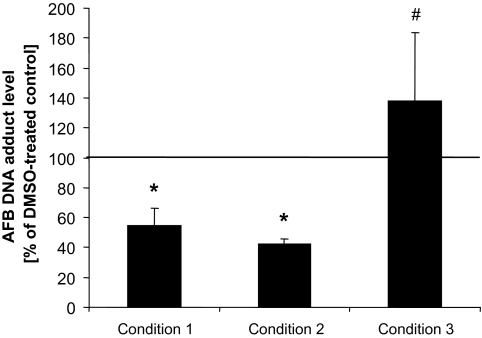FIG. 3.
Modulation of AFB-DNA adduct formation by SFN in cultured human primary hepatocytes at different treatment conditions. To assess contribution of transcriptional versus enzyme inhibition effects, we measured AFB-DNA adduct levels under three different conditions: (1) following a 48-h pretreatment with SFN, cells were incubated for 6 h in media containing 3H-AFB but no SFN (to detect transcriptional effects); (2) following a 48-h pretreatment with SFN, cells were incubated for an additional 6 h in media containing 3H-AFB and SFN (to detect both transcriptional effects and enzyme inhibition effects); (3) following a 48-h treatment with vehicle only (no SFN), cells were incubated for an additional 6 h in media containing 3H-AFB and SFN (to detect enzyme inhibition effects). SFN was applied at 10μM. Conditions 1, 2, and 3 were compared with an analogous treatment without SFN application, which served as control (equal to 100%), for example, following a 48-h treatment with vehicle only (no SFN), cells were incubated for an additional 6 h in media containing 3H-AFB only (no SFN). AFB-DNA adduct levels are expressed as percentages of control and represent means and SDs from three independent experiments (e.g., hepatocytes from three individual preparations). Conditions 1 and 2 were not significantly different from each other, but each was different from control (p < 0.05), marked as “*.” Condition 3 was significantly different from conditions 1 and 2 (p < 0.05) but not from the control (#).

